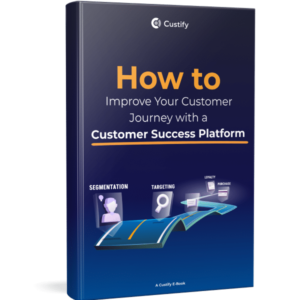Few marketing tasks are as crucial (yet challenging) as uncovering the reasons behind customers’ thoughts and actions. Historically, execs and marketing professionals have relied on quantitative data from customer satisfaction and brand image surveys and qualitative insights from interviews, user tests, and focus groups.
Yes, these are valuable data sources. No, they don’t always accurately reflect customer sentiment. And no, they aren’t enough in today’s landscape.
Why? Both kinds of research rely on customers’ (limited) memory. It’s common for them to recall an ad at a time your company wasn’t running any, for example.
And genuine memories are always at least somewhat biased — a customer may see a larger purchase in a more positive light to avoid ‘buyer’s remorse.’
Web-based tools like social media, Google Analytics, and CRM software suffer less from these challenges because they capture customer experience data in real-time. But, they’re only useful for online interactions, so they fail to account for ~40% of customer-brand touchpoints.
So, what’s the solution?
Customer insight marketing: using data to gain a deep understanding of your customers and their needs.
What is customer insight marketing?
Customer insight marketing is a technology-enabled approach where companies gain a 360-degree view of the customer journey and use this knowledge to create a personalized and consistent customer experience. It bridges the gap between online and offline interactions while providing a holistic understanding of consumer behavior and preferences.
Today’s customers expect personalization at every step of the way. Content, shopping experiences, phone calls with your support team — it all has to hit the mark.
The need for this level of personalization is industry-agnostic. Two-thirds of B2B buyers say they expect the same or more accurately-aimed experiences in their professional lives.
Customer insight marketing addresses that.
The biggest challenge with customer insights today
Put simply, customer insight is anything you learn about your customers that helps you make smarter business decisions. You use it to serve them better, make your business more efficient, or improve the customer experience.
On paper, that sounds simple enough.
In reality? It’s anything but.

Today, SaaS companies have to uncover customer insights at every touchpoint:
- Multichannel marketing communications
- Product adoption
- Internal Customer Success/Support operations
- Subscription renewals/cancellations
- Payment history
- Email opens and clicks
- Social media mentions, likes, comments, and shares
- Survey and customer feedback data
Then, they have to use demographic data, behavioral data, and predictive modeling to segment and analyze it. That’s how they make sense of it and tailor their communications and marketing campaigns to each buyer persona’s unique needs.
While most businesses can access all this information in their respective tools, few use it effectively to meet customer expectations. Since it comes from sources across various stages of the customer lifecycle, it’s impossible to synthesize without a single source of truth.
That’s the biggest challenge of customer insight marketing: “How can we weave this mountain of data into a cohesive story? And how can we act on it?”
3 pillars of customer insight marketing
Although the concept itself is quite extensive, we can simplify the process of turning customer insights into impactful actions into three main components:
- Data
- Automation
- Predictive analytics
Without all three, your customer insight marketing strategy is incomplete.
1. Use data to understand your customers.
Your consumer insights come from several sources:
- Market research
- Social media analytics
- Website data
- Sales and marketing conversions (per email, per page, etc.)
- Purchase history
- Onboarding and product usage data
- Customer success metrics
- Payment processors (billing/subscription management)
Every tool/platform tells you a different part of the story. Using insights to develop strong relationships with your customer base starts with pinpointing specific areas for growth and improvement.
- Do leads drop off at a certain point in the funnel?
- Is there a particular feature your users seem to ignore or struggle with?
- Which content does Customer Segment X engage with most?
You have to collect and cleanse all the data you have available. Once you have it all in one place, you can use data visualization tools to identify trends and patterns. Then, you can apply it to your marketing campaigns and content strategy in a relevant and emotionally intelligent way.
2. Automate personalization and customer success workflows.
Although customer data helps you understand your buyers retrospectively, automation helps you make the real-time changes needed to engage them in the now.
Personalization and consistency are the two things your customers care about most. To deliver those things, you need automated software.
You can use consumer insights to personalize the buying experience in real-time. Examples include:
- A chatbot that connects new leads with the service pages they’re looking for
- Emailing new content to a current subscriber who browsed the product-led content on your website
- Presenting valuable content to a sales rep after a demo
- Dynamic content on landing pages that changes based on the user’s location, language settings, or previous interactions with the brand
Automation goes beyond the sales cycle, though. You might consider Customer Success and Marketing as completely separate departments. The reality is your marketing collateral plays a huge role in customer retention. It’s what primes your customers for a good product experience.
Using in-app messaging, onboarding, product usage, and customer service data, you can create and distribute content that resonates with your buyers over the whole customer lifetime. So, a huge component of customer insight marketing is sharing the right content with customers at particular onboarding stages, post-sales events, and support tickets using automated triggers.
3. Predictive modeling guides you toward proactive strategy.
Let’s say you run a copywriting business which caters to SaaS companies.
There are plenty of ways to get new clients, but creating a strategy to retain your existing customer base is a key to long term success.
The same holds true for SaaS businesses but with software like Custify you can proactively identify customers before they churn more easily.
Predictive modeling with AI and machine learning, can make it easier to score leads, understand churn propensity, and monitor key customer health metrics.
Once you understand customer behavior, you can develop action plans around them.
- Identify the segments with high churn propensity to target for proactive retention efforts.
- Optimize pricing based on real-time consumer and market data.
- Prioritize feature development by mapping user behavior data against predicted future usage patterns.
- Assign a customer health score to each user, combining behavioral and demographic data to identify those with the largest potential for high customer lifetime value.
- Measure customer satisfaction in real-time through surveys and sentiment analysis on social media. You can also create a social media analytics report to measure metrics indicating how satisfied customers are with what you provide.
With forecasted customer behavior patterns and reliable trends forecasts — plus a little marketing creativity — you can launch campaigns that connect with your target audience and drive loyalty for your current customers. And, you can optimize campaign spend by focusing on buyers most likely to convert.
Customer insight vs. market research
There’s an important distinction between the two terms:
- Market research deals with compiling information about markets and customers to make business decisions. It delivers that data in a statistical format.
- Customer insights give context to those stats. They tell you why customers act a certain way.
Market research is certainly a part of customer insight marketing, but overreliance on it will cause you to miss the mark.
As Louis Grenier from EveryoneHatesMarketers explains, market trends and generalizations don’t really underscore the reasons someone would buy your product.
Market research is primarily focused on oversimplified trends and patterns. But customer insight marketing is about what your customers are saying, not what markets are doing.
Customer insight marketing in practice
Whether you run a small copywriting business, a budding ecommerce brand, or a recurring revenue SaaS company, customer insights are life or death.
Of course, there are millions of ways companies use insights to make informed decisions. Here’s a look at how different companies might leverage them to identify areas of improvement and personalize communications:
Health and wellness products

Over time, the Sephora website uses purchase and repurchase insights to understand how long it generally takes customers to use most of a product. To increase its customer lifetime value, Sephora uses next-expected purchase algorithms to send replenishment reminders to its online shoppers automatically.
These automated emails are convenient for the buyer, who probably hasn’t accounted for the lead time between their purchase and the day they’ll run out. They’re invaluable for Sephora because they encourage all the store’s customers to reorder instead of searching elsewhere.
Clothing brands
Nike’s target audience revolves around athletes and aspiring athletes. While a video of Kobe slam dunking looks really cool, the massive clothing brand’s customer engagement reminded them that very few of their customers can actually relate to a top-1% professional athlete.
To speak the language of their typical buyer, the brand launched its ‘Find Your Greatness” campaign. The ads showed real people from all walks of life setting and achieving realistic and relatable goals. Compared to many of its traditional digital marketing campaigns, it was famously one of the most successful.
SaaS vendors

Firstbase is a software platform that helps small business owners and startup founders form their company, manage their documents, set up banking, and run their bookkeeping on one platform.
To deliver the right content to its users at the right time, their marketing team uses a complex segmentation model that factors in the length of time they’ve been in business, their company size, industry, state of formation, growth trajectory, and countless other factors. To market new services like bookkeeping and virtual mailboxes, they’ll send additional upsell emails to lock in customers who haven’t subscribed yet (and convert those who would rather not use a completely separate tool for that purpose).
As they’ve found, when the company sends relevant content — not ‘salesy’ emails — it helps retain customers longer. And, the more quality content they read, the more invested they are in building their own businesses (i.e., with Firstbase).
Final thoughts
It helps to think of customer insight marketing as “using customer insights to make informed marketing decisions.”
For SaaS companies especially, it extends beyond your day-to-day marketing activities — alignment with Sales and Customer Success is a must to correctly interpret, communicate, and apply the insights you collect.
The subscription economy will only get more competitive. That’s how you retain loyal customers.






